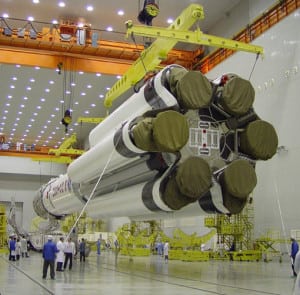Proton Rocket Returns To Uneasy Expectations
[Via Satellite 09-30-2014] After four months, the conclusions regarding Proton’s May 16 failure have been released, citing a “loss of structural integrity of a bolted interface” as the probable cause that led to a series of consequences that ultimately undid the rocket. The International Launch Services (ILS) Failure Review Oversight Board (FROB) drew its conclusions based on information from the Russian State Inter-Agency Commission (IAC) and Proton’s manufacturer, the state-run Khrunichev.
Proton had its first successful launch since the May 16 incident on Sept. 28, orbiting a government relay satellite known as “Ray” or Loutch SC. Since then, the Russian Federal Space Agency Roscosmos has posted the next launch for Oct. 21 to carry the Express AM6 satellite for Russian Satellite Communications Company (RSCC). But the returning Proton faces challenges in the market, with the notion of “business as usual” taking on an uncertain meaning.
Since 2010, Proton has now seen five partial or total launch failures, the latest an apparent human error. With the most recent, the compromised bolted interface, which attached the stage-3 steering engine turbo-pump to the main engine structural frame, resulted in an “excessive steering engine turbo pump vibration environment.” This violent shaking created a fuel leak that shutdown the turbo-pump prematurely, causing the failure less than six minutes into the flight.
“When it’s working it works just fine but, to me, [the May 2014 failure] just sounds like bad workmanship,” said Marco Caceres, senior analyst and director of space studies at the Teal Group. “It could be the bolts were poorly manufactured, it might have been corrosion — maybe they didn’t screw them on tight enough; who knows?”
The Russian government has shuffled leadership at Khrunichev, and continues to evaluate how the organization is run. But while trust might be wavering in the rocket, operators needing to place large satellites in Geostationary Earth Orbit (GEO) have limited alternatives.
“Given the dearth of heavy lift rockets on the market today, the industry has few options at this point,” said Chris Quilty, SVP of equity research at Raymond James & Associates. “Customers will continue to use Proton for the foreseeable future, albeit at a discount to historic launch prices.”
The Russian launch industry has had its setbacks recently, with both ILS and Sea Launch cutting back on personnel due to limited launches. The shifting market could open up new opportunities for competitors with more robust track records.
“United Launch Alliance’s (ULA) Atlas 5 would appear to be the obvious beneficiary of current launch industry turmoil. Unfortunately, questions surrounding the availability of the RD-180 engine could limit the rocket’s availability for commercial customers,” said Quilty.
Caceres agreed that the Atlas 5 could see more success, but cautioned that it needs to become more cost-effective to make it a true competitor. SpaceX, well known for its cost-efficiency, could take a larger piece of the market, having proven itself with several successful launches for NASA and commercial customers. In fact, the company has a very strong manifest of contracted launches, but pressure has been mounting to deliver those launches on time. SpaceX has completed five missions this year with the Falcon 9 vehicle, and has nine more listed before the year’s end. If SpaceX can safely up the pace of its launches, its substantial cost-difference between competitors could propel the company to an even more prominent role.
“Increasingly, you see SpaceX with their Falcon 9 making some inroads into the commercial market, and I think they do have tremendous potential … they just haven’t developed a rhythm for launching lots of commercial satellites. They are doing a little bit of everything and maybe are biting off a little too much to chew,” said Caceres.
Other emerging providers could face a challenging time because they also have difficulty reaching a launch cadence that can meet the needs of the commercial market, according to Caceres. Besides Proton, only Arianespace has managed to balance large government and commercial missions simultaneously. The Chinese space program has taken priority for the Long March rocket family (besides also facing security concerns from the U.S.), and JAXA and ISRO have not managed to launch consistently enough to make a real mark.
“[JAXA and ISRO] need to start launching seven or eight times a year in order to begin to start serving some of the commercial market’s needs. That’s the beauty of the Ariane and Proton vehicles — they are able to cater to the needs of the Russian government on the part of Proton and on the part of the Ariane 5 they can also meet the needs of the European Space Agency, but still have enough missions left over to serve the commercial market. That’s really what makes them unique,” said Caceres. “There is a lot of concern as to the reliability of Proton, but there are not a lot of choices out there.”
